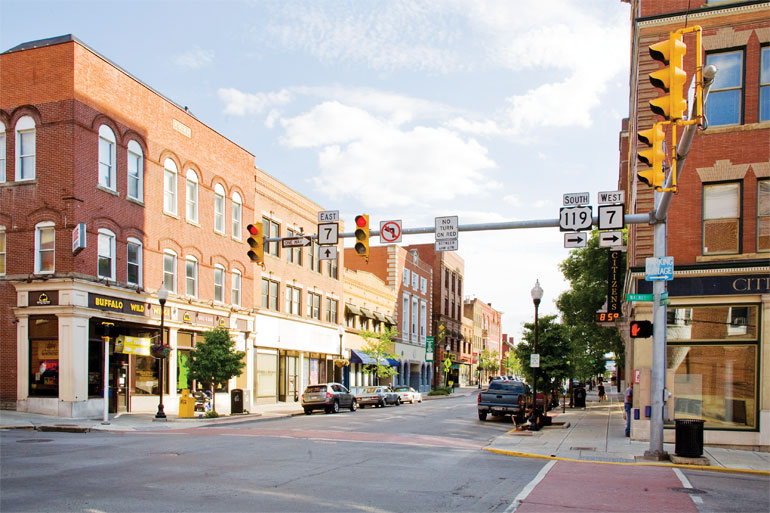journalism and expository writing
Kate began her career as a journalist, and writing and story-telling is never far from her mind. This is a small but curated compilation of her favorite stories, many of which grapple with socio-economic changes in her home state of West Virginia.
west virginia brain drain
“As a teenager, all I wanted was to get out of the state to get better opportunities and different attitudes. I felt like there was nothing I could do to help my home, and I couldn’t find the kind of jobs I wanted,” says Amanda Wenisch, 28, a Mercer County native. A year after graduating college, she moved to Blacksburg, Virginia—just an hour away from the rural community outside of Athens where Wenisch grew up but, as one of Virginia’s fastest growing municipal areas, worlds apart.
Wenisch’s story echoes that of many young West Virginians. The state’s 20-somethings are hefting their tote bags and slamming their car trunks to make a beeline for the highways on their way out of state. They’re not just leaving for college. Our tech-savvy, bold, impatient, and energetic children are all grown up and many are not coming back. As towns across the state shutter windows on businesses and flip the “open” sign to “closed” for the last time, residents are left facing a dwindling economy and a growing concern for the future. Our population is shrinking, and with it our economy and federal representation. The younger generation, those college-bound and 30-somethings, were supposed to steer the state into the future, but will they?
rural food deserts
Fifteen miles on an interstate is a lot different from 15 miles in the middle of Clay or Boone county. A 10-minute drive in larger towns takes you past amenities that require a 30-minute drive out of smaller ones. In 10 minutes, ice cream softens but doesn’t melt. In 10 minutes, frozen chicken forms ice crystals but doesn’t thaw. In 30 minutes, ice cream is a swampy mess and meat gives way at the press of a finger like the flesh of a parent’s arm pulled by a hungry child anxious for lunch. When a grocer is 10 minutes away, you huff at the inconvenience of running back to the store mid-week for the much-needed green beans your spouse forgot to purchase during the weekend shopping trip. When the grocer is 30 minutes away, you do without.
In West Virginia—rural, green, growing West Virginia—more and more people are doing without. The stories fill newspapers. In 2014 Bridgeport lost its last grocery store; Kroger stores in Kanawha and Lewis counties closed; Alderson lost its last store; the Richwood Foodland closed its doors for the last time; and the Whitesville Save A Lot, the only grocery store serving the community for 15 miles, also shuttered. The trend has continued in 2015.
But growing in place of these grocers, in small towns with small populations, are innovative social enterprises dependent on big community. Bridging the gap between relatively high-end local food movements like farmers’ markets and lower-end income-based food pantries and services, these organizations are pioneering an effort to feed the state. It’s an effort that’s more about people than about profit.
upper big branch
On March 23, 2010, a group of safety experts and industry leaders gathered in Washington, D.C., congratulating themselves on another calm year for coal and the 40th anniversary of the Federal Mine Health and Safety Act of 1969. The yearly death toll had dropped from more than 200 fatalities the year the act was signed to just 18 fatalities in 2009. It had been four years since the Sago explosion killed 12 underground coal miners in West Virginia, and the focus of mine safety, many thought, could finally turn from gas leaks and explosions to hygiene and black lung. A new era in mine safety had come at last. The fires and sparks that too often took the lives of the country’s coal miners were relegated to history books. Then, two weeks later, history repeated itself.
Mid-afternoon on April 5, 2010, the tiny mine community of Montcoal in Raleigh County was rocked—literally—by an explosion that would kill 29 men. It would be the deadliest mine accident on U.S. soil in 40 years. “I remember when September 11 happened, and if you’re down in this area it’s the same thing. You could feel it. You could just feel the ground shake,” says Michelle Allen of nearby Whitesville. Methane gas, set off by the sparking of coal dust, ignited the Upper Big Branch mine owned by Massey Energy with a series of explosions that twisted metal and turned safety signs into rocketing projectiles.
In the months that followed, three investigations by the coal workers’ union, federal inspectors, and an independent panel commissioned by the governor concluded a culture of profit before safety, a disengaged government, and a failed inspection system were to blame. Five years later the findings of those investigations continue to play out visibly in federal court. But are our mines any safer?



